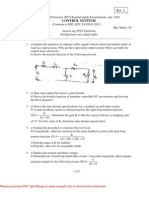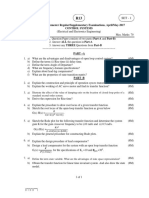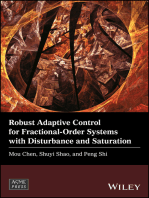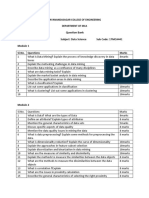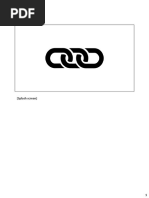Automata
Uploaded by
ukpaditjiAutomata
Uploaded by
ukpaditjiSub Code: BEET 405 ROLL NO……………..……………..
IV-SEMESTER EXAMINATION, 2022 – 23
IInd Yr, B.Tech. –Electronics & Communication Eng/ Electrical Eng
Control system
Duration: 3:00 hrs Max Marks: 100
Note: - Attempt all questions. All Questions carry equal marks. In case of any ambiguity or missing
data, the same may be assumed and state the assumption made in the answer.
Q 1. Answer any four parts of the following. 5x4=20
a) What do you understand by control system? Compare between close loop and open loop system.
b) Find the mathematical model of the system in fig. Also draw its electrical equivalent by using Force
– Voltage analogy.
c) Define gain margin, and phase margin in polar plot.
d) Establish relationship between state equation and transfer function.
e) What is the effect of adding a poles and zeros to a system? Discuss.
f) Explain the correlation between Time and Frequency responses.
Q 2. Answer any four parts of the following. 5x4=20
a)For the system shown in fig, obtain the transfer function by signal flow graph method-
b) Discuss the response of first order system with unit step and unit ramp inputs.
c) State and explain the Nyquist criterion.
d) Derive the expression of maximum peak overshoot.
e) What is steady state error? The open loop transfer function of a unity feedback system is
𝟏𝟎𝟖
given by G (s) =
𝒔𝟐 ( 𝒔+𝟒)(𝒔𝟐 +𝟑𝒔+𝟏𝟐)
Find the steady state error and static error coefficient when subjected to an input by
r (t) = 2 + 5t + 2t2
f) Examine the Controllability of system-
̇ −1 1 𝑥1 1 0
[𝑥1] = [ ][ ] + [ ]u
𝑥2 ̇ 0 −1 𝑥2 0 1
Q 3. Answer any two parts of the following. 10x2= 20
a) Obtain overall transfer function for the given block diagram shown in figure using Block
reduction method-
H3
b) The open loop transfer function of unity feedback system is given by
𝑲
G (s) =
𝒔 ( 𝟏+𝑻 𝒔)
Where ‘ K ‘ & ‘ T' are positive constants. By what factor should the amplifier gain be reduced so that
the peak overshoot of unit step response of the system is reduced from 75% to 25%.
c) A single loop feedback control system has open loop transfer function
𝟏𝟎
G (s) = (𝒔+𝟐)(𝒔+𝟒) . Sketch the Nyquist plot and determine the stability of the closed loop system
by Nyquist criterion.
Q 4. Answer any two parts of the following. 10x2= 20
a) Briefly explain the lag lead compensation technique by having an example.
b) For a unity system the open loop transfer function is given by
𝑲
G(s) =
𝒔 (𝒔+𝟐)(𝒔𝟐 +𝟔𝒔+𝟐𝟓)
(i) Sketch the root locus for 0 ≤ K ≤ ∞.
(ii) At what value of K the system becomes unstable?
(iii) At this point of instability, determine the frequency of oscillation of the system.
c) Using Routh Hurwitz criterion, discuss the stability of the characteristic equation-
s6 +5s5 +11s4 + 25s3+ 36s2+30s + 36=0
Q 5. Answer any two parts of the following. 10x2= 20
a) A second order system has overshoot of 50% and period of oscillation 0.2 sec in step
response. Determine resonant peak, resonant frequency and bandwidth.
b) A single input single output system has transfer function, enlist the state equation and draw the state
diagram.
𝒀 ( 𝒔) 𝟏
T(s) = =
𝑼 (𝒔) 𝒔𝟑 +𝟔𝒔𝟐 +𝟏𝟎𝒔+𝟓
𝟑𝟔 ( 𝟏+𝟎.𝟐 𝒔)
c) Sketch the Bode Plot for the given transfer system G (s) =
𝒔𝟐 ( 𝟏+𝟎.𝟎𝟓 𝒔) ( 𝟏+𝟎.𝟎𝟏𝒔)
for bode plot determine –
(i) Phase crossover frequency
(ii) Gain crossover frequency
(iii) Gain Margin
(iv) Phase Margin
(v) comment on stability of the used system
********** S (n
You might also like
- II B.Tech II Semester, Regular Examinations, April/May - 2012 Control SystemsNo ratings yetII B.Tech II Semester, Regular Examinations, April/May - 2012 Control Systems8 pages
- II B. Tech II Semester II B. Tech II Semester Regular Examinations August - 2014 Control Systems 2014No ratings yetII B. Tech II Semester II B. Tech II Semester Regular Examinations August - 2014 Control Systems 20148 pages
- Btech Ee 5 Sem Control System v2 Ree503 2019No ratings yetBtech Ee 5 Sem Control System v2 Ree503 20192 pages
- III B. Tech I Semester Regular/Supplementary Examinations, October/November - 2016 Control SystemsNo ratings yetIII B. Tech I Semester Regular/Supplementary Examinations, October/November - 2016 Control Systems8 pages
- Subject-Control System-I Que. No. Assignment QuestionsNo ratings yetSubject-Control System-I Que. No. Assignment Questions5 pages
- The LNM Institute of Information Technology Ece and Cce ECE 321: Control System Engineering (End-Term Examination)No ratings yetThe LNM Institute of Information Technology Ece and Cce ECE 321: Control System Engineering (End-Term Examination)17 pages
- Gujarat Technological University: Subject Code:2141004 Subject Name:Control System Engineering Time:10:30 AM To 01:00 PMNo ratings yetGujarat Technological University: Subject Code:2141004 Subject Name:Control System Engineering Time:10:30 AM To 01:00 PM3 pages
- Btech Eee 4 Sem Control System Engineering 1 Pel4i102 2022No ratings yetBtech Eee 4 Sem Control System Engineering 1 Pel4i102 20223 pages
- 141312-141701-Control - Winter - 2013 CT PDFNo ratings yet141312-141701-Control - Winter - 2013 CT PDF2 pages
- CONTROL SYSTEMS & PRACTICE_ECEN 3135_2023No ratings yetCONTROL SYSTEMS & PRACTICE_ECEN 3135_20234 pages
- Dayananda Sagar College of Engineering USN: Model Question PaperNo ratings yetDayananda Sagar College of Engineering USN: Model Question Paper5 pages
- Drttit - Gvet.edu - in Drttit - Gvet.edu - in Drttit - Gvet.edu - in Drttit - Gvet.edu - inNo ratings yetDrttit - Gvet.edu - in Drttit - Gvet.edu - in Drttit - Gvet.edu - in Drttit - Gvet.edu - in2 pages
- Student Solutions Manual to Accompany Economic Dynamics in Discrete Time, secondeditionFrom EverandStudent Solutions Manual to Accompany Economic Dynamics in Discrete Time, secondedition4.5/5 (2)
- Robust Adaptive Control for Fractional-Order Systems with Disturbance and SaturationFrom EverandRobust Adaptive Control for Fractional-Order Systems with Disturbance and SaturationNo ratings yet
- Performance Analysis of Graph Algorithms For Microgrid ProtectionNo ratings yetPerformance Analysis of Graph Algorithms For Microgrid Protection4 pages
- Handwritten Digit Recognition Project PaperNo ratings yetHandwritten Digit Recognition Project Paper15 pages
- A. Vasya The Hipster: CR-1 Implementation Long Challenge (Practice)No ratings yetA. Vasya The Hipster: CR-1 Implementation Long Challenge (Practice)8 pages
- Cvxpy - Convex - Optimization (tcmm2014, Slides)No ratings yetCvxpy - Convex - Optimization (tcmm2014, Slides)43 pages
- Risk assessment of construction projectsNo ratings yetRisk assessment of construction projects15 pages
- Question Bank Semester: IV Sem Subject: Data Science Sub Code: 17MCA441 SL - No. Questions MarksNo ratings yetQuestion Bank Semester: IV Sem Subject: Data Science Sub Code: 17MCA441 SL - No. Questions Marks4 pages
- Multivariate Convex Regression With Adaptive PartitioningNo ratings yetMultivariate Convex Regression With Adaptive Partitioning34 pages
- Segmen 10 Mode Choice - Choice ModellingNo ratings yetSegmen 10 Mode Choice - Choice Modelling6 pages
- Get Fundamentals of Data Science: Theory and Practice 1st Edition Jugal K Kalita Free All Chapters100% (5)Get Fundamentals of Data Science: Theory and Practice 1st Edition Jugal K Kalita Free All Chapters56 pages
- A Brief Overview of Chatgpt: The History, Status Quo and Potential Future DevelopmentNo ratings yetA Brief Overview of Chatgpt: The History, Status Quo and Potential Future Development15 pages







